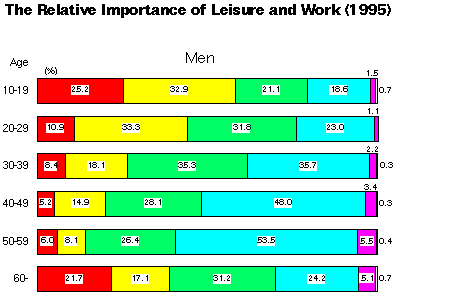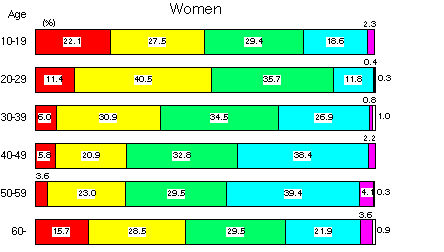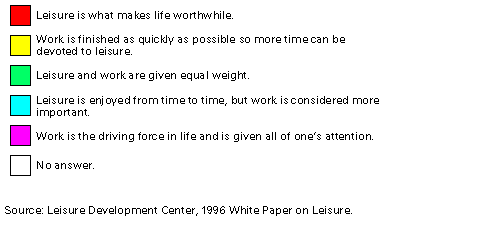


1996 WHITE PAPER ON LEISURE:
People Take Recreation More Seriously
JULY 1, 1996
Leisure Tops Work for First Time
People who consider leisure more important than work now outnumber those who make work the focus of their lives, according to the 1996 white paper on leisure. This is the first time that the white paper found leisure regarded more important than work.
Recently published by the Leisure Development Center, the white paper reported that 34.5%, or 1.8 points higher than the previous year, of respondents in a survey the center conducted said they either considered leisure as being what makes life worthwhile or spent as much time as possible on leisure.
This was slightly higher than the 34.1% (4.6 points lower than last year) who said that work was either the driving force in their lives or more important than leisure.
The white paper was the twentieth published by the Leisure Development Center, which first issued the document in 1977. A total of 4,000 males and females aged 15 years and over were interviewed at the end of last year for the latest survey. Responses were gained from 3,294. Until around 1992, higher income levels and shorter working hours were causing the leisure-oriented group to swell almost annually. This group began to shrink in 1992, however, following the collapse of the "bubble economy". The growth trend returned in the most recent survey after a four-year lapse.
Attitudes to leisure varied according to age and gender. Leisure was most highly valued by males aged 15 to 19, of whom 58.1% rated work over leisure. Next came females aged 20 to 29, at 51.9%. The higher the age, the lower was the emphasis on leisure. Work-oriented males in their fifties, accordingly, reached 59.0%, indicating a complete reversal in attitudes to work and leisure between the younger and older generations.
Communicating Electronically
As to the number of people who actually took part in leisure activities, the most popular recreation was "eating out," enjoyed by an equivalent of 68 million people (extrapolated from the survey results).
Next came "domestic travel" and "going on a drive," each with 60.1 million participants. These figures show that casual activities ranked highest.
The number of participants dropped from the previous year in most categories, perhaps due to the slow recovery. Exceptions were video games, going to the beach, watching movies, and going on picnics.
Thus although more people are inclined to place leisure first, they have not been very adventurous, generally limiting themselves to brief breaks from their daily routines.
The gap between the shares of those who wish to pursue a leisure activity and those who actually do so indicates areas for potential growth. "Overseas travel" rated top in this respect, regardless of age and gender. Next came "domestic travel" and "autocamping". In fourth place, up from eighth last year, was "communicating through computer networks," spurred by the personal computer boom.


